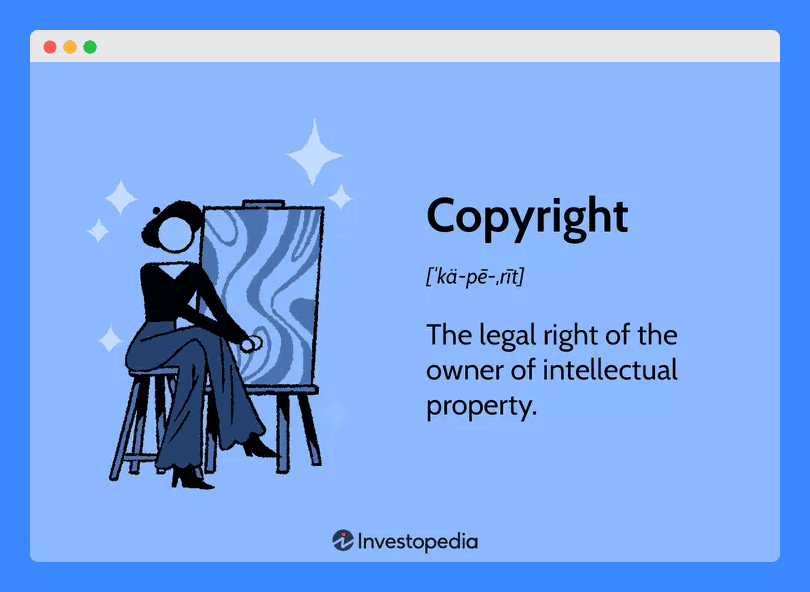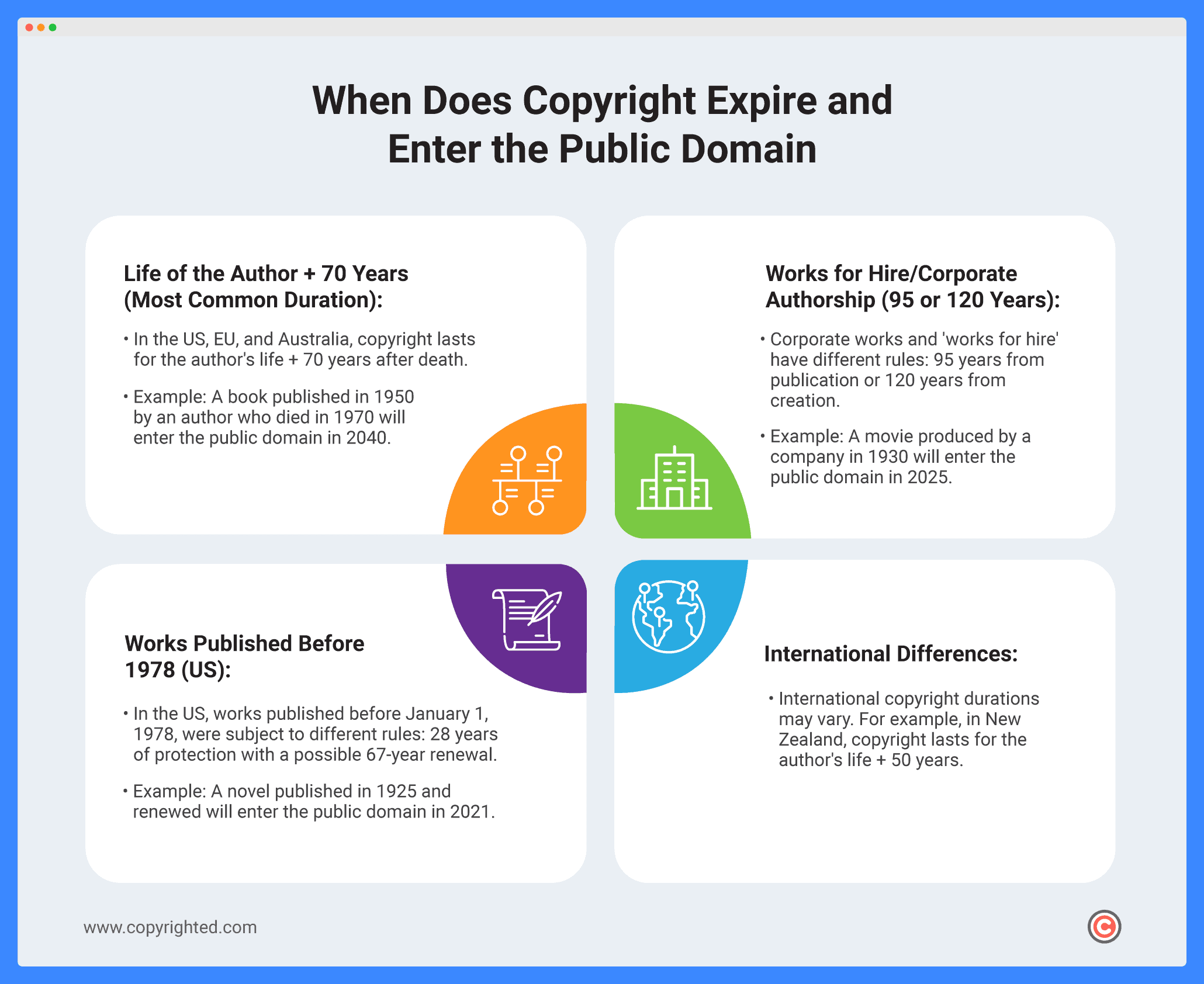Are you curious about the differences between a copyright assignment and a copyright license? If so, you’re in the right place.
It doesn’t matter if you’re a writer, musician, designer, or entrepreneur; copyright plays a crucial role in protecting intellectual property. Understanding how copyright assignment and copyright licensing differ is something else you’ll need to consider if you want to make responsible decisions for your brand. One of the biggest misconceptions we’ve seen in copyright law is the belief that assigning rights and licensing rights are interchangeable.
In reality, they are quite different, with unique legal implications and financial consequences. We want to help break it all down and compare copyright assignment vs. copyright license so you can figure out what choice is best for you.
Let’s dive in!
Table of Contents
Understanding Copyright Basics
Put plainly, copyright is a legal concept that grants all creators exclusive rights to their original work. This protection prevents unauthorized use or reproduction by others.
It serves as a foundation for intellectual property protection, ensuring that authors, artists, and businesses have control over their creations and can benefit from the things that they create.

What Is Copyright Protection?
Copyright protection applies automatically to original works of authorship essentially as soon as they are tangible.
This means most things, including written works, paintings, musical compositions, and even software code, receive copyright protection as soon as they’re created, without the need for formal registration.
However, registering a copyright provides additional legal benefits, including the ability to enforce rights in court.
Rights Granted Under Copyright Law
Copyright law grants the creator several exclusive rights, including:
- Reproduction Right – The right to make copies of their work.
- Distribution Right – The right to distribute these copies to the public.
- Public Performance Right – The right to perform the work publicly (e.g., in theaters, concerts, or broadcasts).
- Public Display Right – The right to display the work publicly (e.g., in museums or galleries).
- Derivative Works Right – The right to create brand new works based on the original (e.g., adaptations, translations, or remixes).
These immensely important rights allow copyright owners to control how their work is used and monetized and offer protection against unauthorized use or infringement.
How Long Does Copyright Protection Last?
The duration of copyright protection varies depending on the jurisdiction and the type of work. In the U.S., for example, copyright typically lasts for the life of the author plus an additional 70 years.
For works created under corporate authorship (such as works for hire), the duration is 95 years from the time of publication or 120 years from the date it was first created, whichever is shorter.
Other countries may have different copyright durations, usually aligning with international treaties like the Berne Convention. You’ll want to review the laws in your area so you fully understand your rights and protections.

Types of Works Protected by Copyright
Copyright always covers a broad range of creative expressions, including:
- Literary works (books, articles, essays, and poems)
- Musical compositions and sound recordings
- Dramatic works (scripts, plays, and screenplays)
- Artistic works (paintings, sculptures, and photographs)
- Motion pictures and audiovisual works
- Software and computer programs
- Architectural designs
If you understand the scope and significance of copyright, you can better manage your intellectual property and protect your rights.
The next section will explore copyright assignment, examining how ownership is transferred and the legal implications involved.
Copyright Assignment Explained
Definition and Legal Context
Copyright assignment is the transfer of ownership of a copyright by the original owner (assignor) to another party or entity (assignee). The transfer is most commonly backed by a document penned that expressly indicates the rights to be transferred.
The original owner retains no control over the copyright any longer after assignment unless otherwise indicated in the agreement. Copyright assignments are governed by national copyright law, which mandates that the agreement be written and signed by the original copyright owner.
Transfer of Ownership
The moment a copyright is assigned, the new owner has full authority over the work as far as reproducing it, distributing it, and licensing it to third parties is concerned. The original creator may still get credit, but they have no legal authority to exploit the work for commercial gains.
Characteristics of Copyright Assignment
Several key characteristics define copyright assignments:
- Permanence of Transfer – Copyright assignment is generally permanent unless the contract includes a reversion clause allowing the original owner to regain rights under specific conditions.
- Complete Transfer of Rights – Unlike licensing, which grants only limited rights, while assignment involves a total transfer of ownership.
- Financial Implications – Assignors may receive a lump-sum payment or royalties, depending on the terms.
When to Consider Copyright Assignment
There are several common scenarios where people may find copyright assignment useful:
- Work-for-Hire Situations – When employees or freelancers create work for a company, employers often require full ownership of the work.
- Corporate Acquisitions – When a company purchases another business, acquiring its copyrighted works is often necessary for continuity.
- Publishing Agreements – Authors and content creators may assign copyrights to publishers in exchange for financial compensation.
While copyright assignment provides a straightforward way to transfer ownership, it also comes with potential downsides, such as losing control over the work. This is why many creators opt for licensing instead.
Copyright License Explained
Definition and Legal Framework
Put simply, a copyright license is an agreement that grants permission to another party to use a copyrighted work under specific terms and conditions.
Unlike copyright assignment, licensing allows the copyright owner to retain ownership while permitting limited use of their work. Licenses can be broad or restrictive, depending on the needs of both parties.
Types of Licenses
- Exclusive Licenses – Only the licensee has the right to use the work, and even the original owner cannot exploit it in the same manner.
- Non-Exclusive Licenses – The copyright owner retains the right to license the work to multiple parties simultaneously.
- Limited Licenses – Restricts how, when, and where the work can be used.
- Perpetual Licenses – Grants long-term usage rights without an expiration date.
Key Components of License Agreements
When drafting a copyright license agreement, several key elements should be considered:
- Scope of Rights Granted – Defines what the licensee can and cannot do with the work.
- Territory and Duration – Specifies the geographic regions where the license is valid and its duration.
- Payment Terms – Includes royalties, lump-sum fees, or revenue-sharing models.
- Usage Restrictions – Limits alterations, sublicensing, or distribution methods.
By opting for licensing instead of assignment, creators can continue to benefit from their intellectual property while allowing others to use their work under mutually agreed-upon terms.
Best Practices to Keep in Mind
- Get Everything in Writing – Clear written agreements are essential for both assignments and licenses. While verbal agreements may be legally binding, written contracts provide clear evidence of what rights were transferred and under what conditions and help prevent costly disputes later.
- Clearly Define the Type of Transfer – Explicitly state whether the agreement is an assignment (complete transfer of ownership) or a license (permission to use). This fundamental distinction affects all other aspects of the agreement and must be unmistakably clear to all parties involved.
- Specify the Scope of Rights – Whether assigning or licensing, clearly outline what rights are being transferred. For assignments, specify if any rights are being retained by the original owner, and if dealing with a license, detail exactly what uses are permitted, including any limitations on territory, duration, or purpose.
- Include Termination and Reversion Rights – Clearly define if and how the agreement can be terminated. For assignments, consider including reversion rights that allow the original creator to reclaim rights under specific conditions. For licenses, specify the circumstances under which either party can end the agreement.
- Address Sublicensing and Transfer Rights – State whether the assignee/licensee can transfer their rights to others. This is particularly important for copyright licenses, where the ability to sublicense can significantly impact the work’s commercial potential and the original owner’s control.
- Outline Financial Terms – Don’t forget to detail all payment arrangements, whether it’s a one-time payment for an assignment or ongoing royalties for a license. Include specific payment schedules, calculation methods, and any audit rights to verify revenue reporting.
Industry-Specific Considerations
Software and Technology
Software and tech companies frequently face tough choices when deciding between copyright assignment and license agreements. Under development agreements, companies will likely want complete assignment of rights by employees and contractors so that they can control their codebase and avoid any complications with product development or sales.
This is especially important for proprietary core technology that provides the company with its competitive edge.
Licensing, however, has been increasingly popular in the software domain, especially with the emergence of SaaS models. Companies need to make serious choices regarding acquiring perpetual licenses, subscription licenses, or hybrid.
Publishing and Literary Works
The publishing world is traditionally where copyright was needed, so it makes sense that this is still true to this day. Most authors prefer licensing agreements in which they are allowed to retain some rights, particularly digital rights or rights in specific territories.
Publishing contracts today entail careful splitting of rights, with authors now opting to sell print rights to traditional publishers and retain e-book rights or audiobook rights for themselves. The hybrid model helps authors optimize their intellectual property across platforms and markets without sacrificing control over more of it.
Music and Entertainment
The record music industry is a very complex industry for copyright issues since there is usually more than one right embodied in a single work (composition, recording, performance). Artists and songwriters favor license agreements over assignments since they can retain ownership of their creative works yet give specific usage rights to labels, streaming firms, or other distributors.
The growth of digital distribution and streaming has contributed to the appeal of licensing since it enables artists to adjust to new technology and distribution means without losing control of their creations. New artists, nevertheless, might continue to experience pressure to relinquish their rights to major labels in return for marketing and distribution services.
Visual Arts and Photography
Visual artists and photographers generally benefit from licensing agreements that enable them to retain ownership while generating multiple revenues for the same work. Stock photography, for example, generally functions on a license model that permits photographers to sell usage rights to more than one client at a time.
Nonetheless, when it comes to developing commissioned or corporate work, artists can expect calls for complete assignment of rights. The choice between assignment and license usually depends on intended use, client requirements, and the prospect of future licensing activity.
Academic and Research
Universities are inclined to choose license terms under which research results are disseminated extensively while the institution retains ownership. Such is the case, especially for research with commercial potential or patent value. Universities usually seek to strike a balance between academic dissemination and commercialization potential.
Joint research with institutions or with industry must consider how intellectual property rights are to be managed. Whereas complete assignments might be suitable for industry-supported research, license agreements generally give greater accommodation for academic use as well as use in future research.
Common Pitfalls and How to Avoid Them
- Failing to Define Transfer Type – One of the worst mistakes is using ambiguous language that doesn’t clearly indicate whether the agreement is an assignment or license. Always explicitly state the type of transfer in the agreement’s title and opening paragraphs. Use specific language like “hereby assigns and transfers” for assignments or “hereby grants a license” for licenses.
- Overlooking Reversion Rights – Many creators fail to include provisions for reclaiming their rights if the assignee or licensee fails to exploit the work or goes bankrupt. Include clear reversion triggers and procedures in your agreement, specifying exactly what conditions must be met for rights to return to the original owner.
- Poor Scope Definition – Vague or overly broad descriptions of rights being transferred can lead to serious disputes. Address this by creating detailed lists of included rights, specifically stating any exclusions, and clearly defining territorial limits and duration. Consider including examples of permitted and prohibited uses to remove ambiguity.
- Ignoring New Tech – Many older agreements have become problematic because they didn’t account for new distribution methods or technologies. Include forward-looking provisions that address how you’ll handle future technologies or limit the agreement to current known technologies and require new negotiations for future developments.
- Poor Financial Terms Structure – Creators often accept simple one-time payments without considering the long-term value of their work. Structure financial terms to align with the actual value and potential uses of the work. For licenses, consider combining upfront payments with royalties. For assignments, consider price adjustments based on commercial success.
- Insufficient Quality Control Provisions – Many agreements fail to address how the work can be modified or adapted. Include specific quality control provisions that detail approval rights for modifications, minimum quality standards, and branding requirements. This is particularly important for licenses where the original creator’s reputation might be affected by poor-quality adaptations.
Conclusion
The choice between copyright assignment and licensing is an important one for creators and businesses alike. Understanding the fundamental differences between these two mechanisms is crucial for making the right choice for your business.
Assignments offer a clean break and complete transfer of rights, which can be advantageous in certain situations. Licensing, on the other hand, provides flexibility and ongoing control while potentially generating multiple revenue streams but requires more active management and monitoring of relationships.
The key to successful copyright transactions lies in analyzing your specific circumstances and long-term goals.
Whether choosing assignment or licensing, the goal should be to create clear, comprehensive agreements that serve both current needs and set you up for success.


